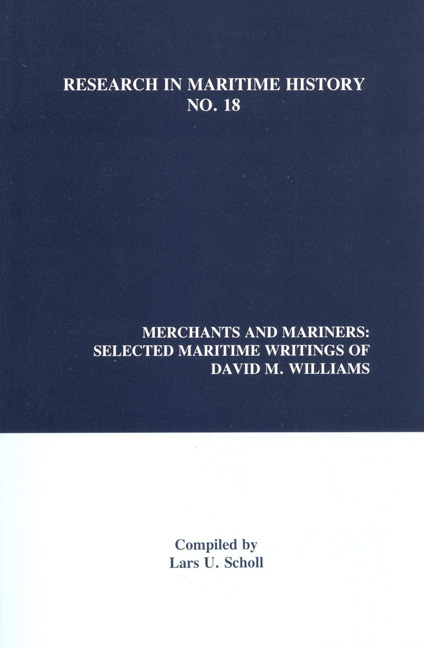Book contents
- Frontmatter
- Contents
- “Introduction”
- “David Malcolm Williams: A Tribute from an Old Friend”
- “David M. Williams and the Writing of Modern Maritime History”
- Writings
- “Abolition and the Re-Deployment of the Slave Fleet, 1807-1811”
- “Liverpool Merchants and the Cotton Trade 1820-1850”
- “The Shipping of the North Atlantic Cotton Trade in the Mid- Nineteenth Century”
- “Merchanting in the First Half of the Nineteenth Century: The Liverpool Timber Trade”
- “James Silk Buckingham: Sailor, Explorer and Maritime Reformer”
- “State Regulation of Merchant Shipping 1839-1914: The Bulk Carrying Trades”
- “Customs Evasion, Colonial Preference and the British Tariff, 1829- 1842”
- “Bulk Passenger Freight Trades, 1750-1870”
- “Henry Mayhew and the British Seaman”
- “Mid-Victorian Attitudes to Seamen and Maritime Reform: The Society for Improving the Condition of Merchant Seamen, 1867”
- '“Advance Notes' and the Recruitment of Maritime Labour in Britain in the Nineteenth Century”
- “The Quality, Skill and Supply of Maritime Labour: Causes of Concern in Britain, 1850-1914”
- “David M. Williams: A Bibliography”
“Liverpool Merchants and the Cotton Trade 1820-1850”
from Writings
- Frontmatter
- Contents
- “Introduction”
- “David Malcolm Williams: A Tribute from an Old Friend”
- “David M. Williams and the Writing of Modern Maritime History”
- Writings
- “Abolition and the Re-Deployment of the Slave Fleet, 1807-1811”
- “Liverpool Merchants and the Cotton Trade 1820-1850”
- “The Shipping of the North Atlantic Cotton Trade in the Mid- Nineteenth Century”
- “Merchanting in the First Half of the Nineteenth Century: The Liverpool Timber Trade”
- “James Silk Buckingham: Sailor, Explorer and Maritime Reformer”
- “State Regulation of Merchant Shipping 1839-1914: The Bulk Carrying Trades”
- “Customs Evasion, Colonial Preference and the British Tariff, 1829- 1842”
- “Bulk Passenger Freight Trades, 1750-1870”
- “Henry Mayhew and the British Seaman”
- “Mid-Victorian Attitudes to Seamen and Maritime Reform: The Society for Improving the Condition of Merchant Seamen, 1867”
- '“Advance Notes' and the Recruitment of Maritime Labour in Britain in the Nineteenth Century”
- “The Quality, Skill and Supply of Maritime Labour: Causes of Concern in Britain, 1850-1914”
- “David M. Williams: A Bibliography”
Summary
Our knowledge of merchanting and commerce in Liverpool in the first half of the nineteenth century is surprisingly slight. Even in the case of the cotton trade, rightly by virtue of its size and importance the best documented of the port's trades, there are remarkable gaps in our understanding. The eighteenth-century origins of the trade, its dramatic expansion after 1780, the evolution of the cotton market, the emergence of the specialist broker as the lynch pin on which sales depended, and the beginnings of future trading, have all been subjects of scholarly study, yet many features of the trade and its organisation still await research. One such feature is the structure and character of that section of the merchant body which imported cotton into Liverpool. Very little is known about the Liverpool cotton merchant; true the names of Cropper, Brown, Baring and Coliman are familiar enough and there is Dr. Mariner's excellent study of the Rathbones and their trading operations, but of the cotton merchants as a group, or as individual entrepreneurs, our information is really superficial. We do not know who the cotton merchants were or how many importers were active in the trade. Similarly, the importer's scale of operation and the reaction of the merchant body to the tremendous growth of the trade are issues of doubt. The purpose of this short paper is to remedy these deficiencies in our knowledge through a study of Liverpool's cotton merchants in the first half of the nineteenth century with particular reference to the period after 1820. The choice of the year 1820 as an opening date was influenced by two factors, namely, the regaining of stability in the trade following the dislocations of the war and of the immediate post-war period and the availability of source material. It is proposed to consider first the degree of concentration prevailing in the cotton trade between 1820 and 1839 and then to examine more generally the changing role and function of the individual merchant over the slightly longer period from 1820 to 1850.
The period 1820 to 1850 was one of immense expansion in the cotton trade. Within thirty years imports of cotton into Liverpool increased threefold, from under half a million bales in 1820 to well over a million and a half bales in 1850.
- Type
- Chapter
- Information
- Merchants and MarinersSelected Maritime Writings Of David M. Williams, pp. 19 - 52Publisher: Liverpool University PressPrint publication year: 2000



